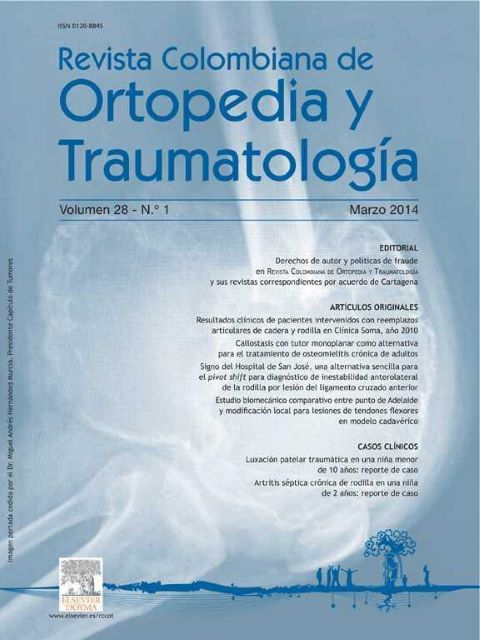Comparative biomechanical study between the Adelaide suture and local modification for flexor tendon injuries in a cadaver model
DOI:
https://doi.org/10.1016/S0120-8845(15)30005-5Keywords:
flexor tendon, tenorrhaphy, biomechanical study, Adelaide pointAbstract
Background: Blocked configurations in tendon repair offer higher tensile strength to cavitational spaces in the area of attachment of sectioned tendon ends, when compared to configurations with more grip. The objective of this study is to evaluate the biomechanical behavior of the Adelaide stitch suture (double-double crossover blocked) compared to a local modification (triple cross-double locked) in the tendons of a Colombian population.
Methods: Ten human tendons obtained from a dissected cadaver, with eight corresponding to the flexor digitorum profundus and two of them to the flexor pollicis longus. A cross-section was performed on each tendon at zone II, followed by tenorrhaphy using 3-0 braided green polyester (Ethibon). Each tenorrhaphy was subjected to a failure load test (Universal Testing Machine Shimadzu, software: Trapezium 2.0). Two groups, each one with five tendons, were used to compare the biomechanical behavior between the Adelaide suture and the local modification.
Results: The final load failure was similar in both groups. No significant differences were found in the point of stitch suture dehiscence at 2 mm, with mean values of 40 N in the Adelaide suture and 39 N in the group with the local modification suture technique. In 70% of cases, a material failure occurred, without the loss of the suture configuration. Only in 30% of cases was the failure due to tear of the tendon suture.
Discussion: The findings showed biomechanical advantage to four strands of sutures, as well as their reproducibility over the surgical technique. The lack of findings on the material suggest that clinical research should focus on introducing stronger sutures rather than changing surgical techniques.
Downloads
References
Strickland JW. Flexor tendon injuries: Foundations of treatment. J Am Acad Orthop Surg. 1995;3:44-54. https://doi.org/10.5435/00124635-199501000-00006
Sandow MJ, McMahon MM. Single-cross grasp six-strand repair for acute à exor tenorrhaphy. ModiÞ ed Savage technique. Atlas Hand Clin. 1996;1:41-64.
Angeles JG, Heminger H, Mass DP. Comparative biomechanical performances of 4-strand core suture repairs for zone II à exor tendon lacerations. J Hand Surg Am. 2002;27:508-17. https://doi.org/10.1053/jhsu.2002.32619
Croog A, Goldstein R, Nasser P, et al. Comparative biomechanic performance of locked cruciate four-strand à exor tendon repairs in an ex vivo porcine model. J Hand Surg Am. 2007;32:225-32. https://doi.org/10.1016/j.jhsa.2006.11.009
Hirpara KM, Sullivan PJ, Raheem O, et al. A biomechanical analysis of multistrand repairs with the Silfverskiold peripheral cross-stitch. J Bone Joint Surg Br. 2007;89:1396-401. https://doi.org/10.1302/0301-620X.89B10.19360
Barrie KA, Tomak SL, Cholewicki J, et al. Effect of suture locking and suture caliber on fatigue strength of à exor tendon repairs. J Hand Surg. 2001;26A:340-6. https://doi.org/10.1053/jhsu.2001.22926
Barrie KA, Tomak SL, Cholewicki J, et al. The role of multiple strands and locking sutures on gap formation of à exor tendon repairs during cyclical loading. J Hand Surg. 2000;25A:714-20. https://doi.org/10.1053/jhsu.2000.9414
Wade PJF, Wetherell Rg, Amis AA. Flexor tendon repair: Significant gain in strength from the Halsted peripheral suture technique. J Hand Surg. 1989;14B:232-5. https://doi.org/10.1016/0266-7681_89_90135-6
Peltz TS, Haddad R, Scougall PJ. Influence of locking stitch size in a four-strand cross-locked cruciate à exor tendon repair. J Hand Surg Am. 2011;36:450-5. https://doi.org/10.1016/j.jhsa.2010.11.029
Downloads
Published
How to Cite
Issue
Section
License
Copyright (c) 2024 Revista Colombiana de ortopedia y traumatología

This work is licensed under a Creative Commons Attribution 3.0 Unported License.




